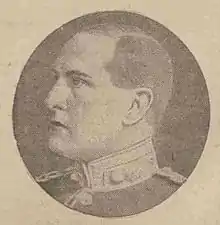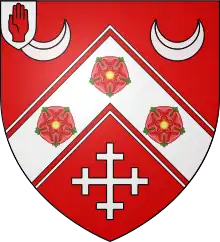Lees Knowles
Sir Lees Knowles, 1st Baronet CVO (16 February 1857 – 7 October 1928) was a British barrister, military historian and Conservative politician.[1]

Biography
Knowles was the son of John Knowles and Elizabeth Lees of Green Bank, Oldham, Lancashire whose family owned Andrew Knowles and Sons, collieries in the Irwell Valley. He was educated at Rugby School and at Trinity College, Cambridge.[2] He was a prominent athlete at both institutions and became president of the Cambridge University Athletics Club. He studied law, and was called to the bar at Lincoln's Inn in 1882.
He was involved in Unionist politics, and stood unsuccessfully for the Conservatives at Leigh in the 1885 general election.
In the following year, another general election was held, and Knowles was returned as Member of Parliament for Salford West. From 1887 to 1892 he held an appointment as unpaid parliamentary secretary to Charles Ritchie, President of the Local Government Board. He held a similar post when Ritchie became President of the Board of Trade in 1895. From 1896 to 1906 he was Second Church Estates Commissioner. In 1903 he was created a baronet, "of Westwood in the County of Lancaster". His parliamentary career came to an end when he lost his seat at the 1906 general election.
Knowles had a great interest in military history, and wrote a number of books on the life of Napoleon. In 1912 he made a bequest to his alma mater, Trinity College. This established the Lees Knowles Lectureship, an annual series of talks on military science given by distinguished military and naval figures.
He held a commission as an officer in the Volunteer Force and its successor the Territorial Force, reaching the rank of lieutenant-colonel. After a stint as Honorary Colonel of the 3rd (Volunteer) battalion of the Lancashire Fusiliers, he was on 14 May 1902 appointed lieutenant-colonel in command of the battalion.[3] At various times he commanded the 3rd, 7th and 8th battalions of the Lancashire Fusiliers. He subsequently became the vice-chairman of the Lancashire Territorial Army Association.
In 1915, he married Lady Nina Ogilvy, youngest daughter of the 10th Earl of Seafield. Lady Nina was presumably the Lady Nina Ogilvy Grant who appeared at a meeting of the Conservative and Unionist Women's Franchise Association on 11 May 1909 at 52 Portland Place in London, as reported by Votes for Women, the organ of the Women's Social and Political Union.[4] They had no children.[5]
Knowles was a philanthropist, supporting a number of charities, notably the Guinness Trust for Housing the Poor. He died in October 1928, aged 71, at his home in Westwood, Pendlebury.[5]
Two roads in Llandudno, North Wales, are named in his honour: Lees Road and Knowles Road.
Arms
 |
|
Works
- Lees Knowles, A day with corps-students in Germany
- Knowles, Lees (1914). Minden and the Seven Years War. Simpkin, Marshall, Hamilton, Kent & Company.
- As editor
- Lutyens, Engelbert (1915). Knowles, Lees (ed.). Letters of Captain Engelbert Lutyens: Orderly Officer at Longwood, Saint Helena: Feb. 1820 to Nov. 1823. John Lane.
References
- Genealogical and Heraldic Dictionary of the Peerage and Baronetage of the British Empire. Burke's Peerage Limited. 1914. pp. 1145–1146. Retrieved 27 August 2017.
- "Knowles, Lees (KNWS875L)". A Cambridge Alumni Database. University of Cambridge.
- "No. 27433". The London Gazette. 13 May 1902. p. 3182.
- "Conservative and Unionist Women's Franchise Association". Votes for Women. 21 May 1909.
- "Obituary". The Press. LXIV (19485). 5 December 1928. p. 16. Retrieved 17 October 2014.
- Fairbairn, James (1892). Fairbairn's Book of Crests of the Families of Great Britain and Ireland. Jack. p. 51. Retrieved 27 August 2017.
- "Cheshire Soldiers of Fortune: Sir Robert Knolles". Journal of the Architectural, Archaeological, and Historic Society for the County and the City of Chester and North Wales: 224. 1908. Retrieved 27 August 2017.
- Burke, John; Burke, Bernard (1842). A General Armory of England, Scotland, and Ireland. Edward Churton. p. 620. Retrieved 27 August 2017.
- 'Obituary: Sir Lees Knowles. A Life of Public Service.', The Times, 8 October 1928, p. 18
External links
- Hansard 1803–2005: contributions in Parliament by Sir Lees Knowles
| Parliament of the United Kingdom | ||
|---|---|---|
| Preceded by Benjamin Armitage |
Member of Parliament for Salford West 1886 – 1906 |
Succeeded by Sir George Wiliam Agnew |
| Baronetage of the United Kingdom | ||
| New creation | Baronet (of Westwood and Turton Tower in the County of Lancaster) 1903 – 1928 |
Extinct |